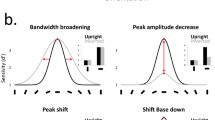Abstract
A previous experiment showed that a chimpanzee performed better in searching for a target human face that differed in orientation from distractors when the target had an upright orientation than when targets had inverted or horizontal orientation [Tomonaga (1999a) Primate Res 15:215–229]. This upright superiority effect was also seen when using chimpanzee faces as targets but not when using photographs of a house. The present study sought to extend these results and explore factors affecting the face-specific upright superiority effect. Upright superiority was shown in a visual search for orientation when caricaturized human faces and dog faces were used as stimuli for the chimpanzee but not when shapes of a hand and chairs were presented. Thus, the configural properties of facial features, which cause an inversion effect in face recognition in humans and chimpanzees, were thought to be a source of the upright superiority effect in the visual search process. To examine this possibility, various stimuli manipulations were introduced in subsequent experiments. The results clearly show that the configuration of facial features plays a critical role in the upright superiority effect, and strongly suggest similarity in face processing in humans and chimpanzees.






Similar content being viewed by others
References
Ballaz C, Boutsen L, Peyrin C, Humphreys GW, Marendaz C (2005) Visual search for object orientation can be modulated by canonical orientation. J Exp Psychol Hum Percept Perform 31:20–39
Blough DS (1979) Effects of the number and form of stimuli on visual search in the pigeon. J Exp Psychol Anim Behav Process 5:211–223
Bruce C (1982) Face recognition by monkeys: absence of an inversion effect. Neurophsychologia 20:515–521
Campbell R, Walker J, Baron-Cohen S (1995) The development of differential use of inner and outer face features in familiar face identification. J Exp Child Psychol 59:196–210
Carey S, Diamond R (1977) From piecemeal to configurational representation of faces. Science 195:312–314
Carey S, Diamond R (1994) Are faces perceived as configurations more by adults than by children? Visual Cogn 1:253–274
Diamond R, Carey S (1986) Why faces are and are not special: an effect of expertise. J Exp Psychol 115:107–117
Dittrich WH (1990) Representation of faces in longtailed macaques (Macaca fascicularis). Ethology 85:265–278
Ellis HD, Shepherd JW, Davies GM (1979) Identification of familiar and unfamiliar faces from internal and external features: some implications for theories of face recognition. Perception 8:431–439
Fagot J, Tomonaga M (1999) Global-local processing in humans (Homo sapiens) and chimpanzees (Pan troglodytes): use of a visual search task with compound stimuli. J Comp Psychol 113:3–12
Farah MJ, Tanaka JW, Drain HM (1995) What causes the face inversion effect? J Exp Psychol Hum Percept Perform 21:628–634
Gothard KM, Erickson CA, Amaral DG (2004) How do rhesus monkeys (Macaca mulatta) scan faces in a visual paired comparison task? Anim Cogn 7:25–36
von Grünau M, Anston C (1995) The detection of gaze direction: a stare-in-the-crowd effect. Perception 24:1297–1313
Hamilton CR, Vermeire BA (1983) Discrimination of monkey faces by split-brain monkeys. Behav Brain Res 9:263–275
Hamilton CR, Vermeire BA (1988) Complementary hemispheric specialization in monkeys. Science 242:1691–1694
Hansen C, Hansen R (1988) Finding the face in the crowd: an anger superiority effect. J Pers Soc Psychol 54:917–924
Hershler O, Hochstein S (2005) At first sight: a high-level pop out effect for faces. Vis Res 45:1707–1724
Hunnius S, Geuze RH (2004) Developmental changes in visual scanning of dynamic faces and abstract stimuli in infants: a longitudinal study. Infancy 6:231–255
Jitsumori M, Matsuzawa T (1991) Picture perception in monkeys and pigeons: transfer of rightside-up versus upside-down discrimination of photographic objects across conceptual categories. Primates 32:473–482
Johnson MH, Morton J (1991) Biology and cognitive development the case of face recognition. Blackwell, Cambridge
Kanazawa S (1996) Recognition of facial expressions in a Japanese monkey (Macaca fuscata) and humans (Homo sapiens). Primates 37:25–38
Keating CF, Keating EG (1993) Monkeys and mug shots: cues used by rhesus monkeys (Macaca mulatta) to recognize a human face. J Comp Psychol 107:131–139
Kuwahata H (2004) Comparative–cognitive studies on face recognition in primates. PhD dissertation, Kyoto University, Japan
Kuwahata H, Fujita K, Ishikawa S, Myowa-Yamakoshi M, Tomonaga M, Tanaka M, Matsuzawa T (2003) Recognition of facial patterns in infant chimpanzees (in Japanese). In: Tomonaga M, Tanaka M, Matsuzawa (eds) Cognitive and behavioral development in chimpanzees: a comparative approach. Kyoto University Press, Kyoto pp 89–93
Levin DT (1996) Classifying faces by race: the structure of face categories. J Exp Psychol Learn Mem Cogn 22:1364–1382
Lewis MB, Edmonds AJ (2005) Searching for faces in scrambled scenes. Visual Cogn 12:1309–1336
Luria AR, Pravdina-Vinarskaya EN, Yarbus AL (1964) Eye movement mechanisms in normal and pathological vision. Sov Psychol Psychiatry 2:28–39
Malinowski P, Hübner R (2001) The effect of familiarity on visual-search performance: evidence for learned basic features. Percept Psychophys 63:458–463
Martin-Malivel J, Fagot J (2001) Perception of pictorial human faces by baboons: effects of stimulus orientation on discrimination performance. Anim Learn Behav 29:10–20
Masuda S (2003) Effect of familiarity on visual search for faces (in Japanese). In: Proceedings of the 67th annual convention of the Japanese Psychological Association. Japanese Psychological Association, Tokyo, p 599
Matsuzawa T (1990) Form perception and visual acuity in a chimpanzee. Folia Primatol 55:24–32
Montoute T, Tiberghien G (2001) Unconscious familiarity and local context effects on low-level face processing: a reconstruction hypothesis. Conscious Cogn 10:503–523
Myowa-Yamakoshi M, Tomonaga M, Tanaka M, Matsuzawa T (2003) Preference for human direct gaze in infant chimpanzees (Pan troglodytes). Cognition 89:B53–64
Myowa-Yamakoshi M, Yamaguchi M, Tomonaga M, Tanaka M, Matsuzawa T (2005) Development of face recognition in infant chimpanzees (Pan troglodytes). Cogn Dev 20:49–63
Nahm FKD, Perrett A, Amaral DG, Albright TD (1998) How do monkeys look at faces? J Cogn Neurosci 9:611–623
Nothdurft HC (1993) Faces and facial expressions do not pop out. Perception 22:1287–1298
Ochiai T, Matsuzawa T (1998) Planting trees in an outdoor compound of chimpanzees for an enriched environment. In: Hare VJ, Worley E (eds) Proceedings of the third international conference on environmental enrichment. The Shape of Enrichment, San Diego pp 355–364
Öhman A, Lundqvist D, Esteves F (2001) The face in the crowd revisited: a threat advantage with schematic stimuli. J Pers Soc Psychol 80:381–396
Overman WH, Doty RW (1982) Hemispheric specialization displayed by man but not macaques for analysis of faces. Neuropsychologia 20:113–128
Parr LA, Dove T, Hopkins WD (1998) Why faces may be special: evidence of the inversion effect in chimpanzees. J Cogn Neurosci 10:615–622
Parr LA, Winslow IT, Hopkins WD (1999) Is the inversion effect in rhesus monkey face-specific? Anim Cogn 2:123–129
Perrett DI, Mistlin AJ (1990) Perception of facial characteristics by monkeys. In: Stebbins WC, Berkley MA (eds) Comparative perception vol 2, Wiley, New York, pp 178–215
Phelps MT, Roberts WA (1994) Memory for pictures of upright and inverted primate faces in humans (Homo sapiens), squirrel monkeys (Saimiri sciureus), and pigeons (Columbia livia). J Comp Psychol 108:114–125
Purcell DG, Stewart AL (1986) The face-detection effect. Bull Psychon Soc 24:118–120
Purcell DG, Stewart AL (1988) The face-detection effect: configuration enhances detection. Percept Psychophys 43:355–366
Rosenfeld SA, Van Hoesen GW (1979) Face recognition in the rhesus monkey. Neuropsychologia 175:503–509
Sato N, Nakamura K (1999) Detection of directed gaze in rhesus monkeys (Macaca mulatta). J Comp Psychol 115:115–121
Senju A, Hasegawa T, Tojo Y (2005) Does perceived direct gaze boost detection in adults and children with and without autism? The stare-in-the-crowd effect revisited. Visual Cogn 12:1474–1496
Shen J, Reingold EM (2001) Visual search asymmetry: the influence of stimulus familiarity and low-level features. Percept Psychophys 63:464–475
Suzuki S, Cavanagh P (1995) Facial organization blocks access to low-level features: an object inferiority effect. J Exp Psychol Hum Percept Perform 21:901–913
Tanaka JW, Farah MJ (1991) Second-order relational properties and the inversion effect: testing a theory of face perception. Percept Psychophys 50:367–372
Tomonaga M (1993a) Use of multiple-alternative matching-to-sample in the study of visual search in a chimpanzee (Pan troglodytes). J Comp Psychol 107:75–83
Tomonaga M (1993b) Tests for control by exclusion and negative stimulus relations of arbitrary matching to sample in a “symmetry-emergent” chimpanzee. J Exp Anal Behav 59:215–229
Tomonaga M (1994) How laboratory-raised Japanese monkeys (Macaca fuscata) perceive rotated photographs of monkeys: evidence for an inversion effect in face perception. Primates 35:155–165
Tomonaga M (1995) Visual search by chimpanzees (Pan): assessment of controlling relations. J Exp Anal Behav 63:175–186
Tomonaga M (1997) Precuing the target location in visual searching by a chimpanzee (Pan troglodytes): effects of precue validity. Jpn Psychol Res 39:200–211
Tomonaga M (1999a) Visual search for orientation of faces by a chimpanzee (Pan troglodytes) (in Japanese with English abstract). Primate Res 15: 215–229
Tomonaga M (1999b) Inversion effect in perception of human faces in a chimpanzee (Pan troglodytes). Primates 40:417–438
Tomonaga M (1999c) Establishing functional classes in a chimpanzee (Pan troglodytes) with a 2-item sequential-responding procedure. J Exp Anal Behav 72:57–79
Tomonaga M (2001a) Investigating visual perception and cognition in chimpanzees (Pan troglodytes) through visual search and related tasks: from basic to complex processes. In: Matsuzawa T (eds) Primate origin of human cognition and behavior. Springer, Tokyo, pp 55–86
Tomonaga M (2001b) Visual search for biological motion patterns in chimpanzees (Pan troglodytes). Psychologia 44:46–59
Tomonaga M, Matsuzawa T (1992) Perception of complex geometric figures in chimpanzees (Pan troglodytes) and humans (Homo sapiens): analyses of visual similarity on the basis of choice reaction time. J Comp Psychol 106:43–52
Tomonaga M, Itakura S, Matsuzawa T (1993) Superiority of conspecific faces and reduced inversion effect in face perception by a chimpanzee. Folia Primatol 61:110–114
Tomonaga M, Myowa-Yamakoshi M, Mizuno Y, Yamaguchi MK, Kosugi D, Bard KA, Tanaka M, Matsuzawa T (2004) Development of social cognition in infant chimpanzees (Pan troglodytes): face recognition, smiling, gaze and the lack of triadic interactions. Jpn Psychol Res 46:227–235
Tong F, Nakayama K (1999) Robust representations for faces: evidence from visual search. J Exp Psychol Hum Percept Perform 25:1016–1035
Treisman A, Gelade G (1980) A feature-integration theory of attention. Cogn Psychol 12:97–136
Valentine T (1988) Upside-down faces: a review of the effects of inversion upon face recognition. Br J Psychol 79:471–491
Wang Q, Cavanagh P, Green M (1994) Familiarity and pop-out in visual search. Percept Psychophys 56:495–500
Williams M, Moss SA, Bradshaw JL, Mattingley JB (2005) Look at me, I’m smiling: visual search for threatening and nonthreatening facial expressions. Visual Cogn 12:29–50
Wolfe JM (2001) Asymmetries in visual search: an introduction. Percept Psychophys 63:381–389
Wright AA, Roberts WA (1996) Monkey and human face perception: inversion effects for human but not for monkey faces or scenes. J Cogn Neurosci 8:278–290
Yamaguchi MK, Hirukawa T, Kanazawa S (1995) Judgment of gender through facial parts. Perception 24:563–575
Yarbus AL (1967) Eye movements and vision. Plenum, New York
Yin RK (1969) Looking at upside-down faces. J Exp Psychol 81:141–145
Acknowledgments
This study and preparation of the manuscript were financially supported by Grants-in-Aid for Scientific Research from the Japanese Ministry of Education, Culture, Sports, Science and Technology (MEXT), Japan Society for the Promotion of Science (JSPS; Grant # 04710053, 05206113, 05710050, 07102010, 09207105, 10CE2005, 12002009, 13610086, 16002001, 16300084) and MEXT Grants-in-Aid for the 21st Century COE Program (A14 and D10). The author wishes to thank Drs. Tetsuro Matsuzawa and Masayuki Tanaka for their valuable comments on this study. Thanks are also due to Sumiharu Nagumo for his technical support and to Kiyonori Kumazaki, Norihiko Maeda, and the staff of the Center for Human Evolution Modeling Research of the Primate Research Institute (PRI) for their care of the chimpanzees.
Author information
Authors and Affiliations
Corresponding author
About this article
Cite this article
Tomonaga, M. Visual search for orientation of faces by a chimpanzee (Pan troglodytes): face-specific upright superiority and the role of facial configural properties. Primates 48, 1–12 (2007). https://doi.org/10.1007/s10329-006-0011-4
Received:
Accepted:
Published:
Issue Date:
DOI: https://doi.org/10.1007/s10329-006-0011-4




